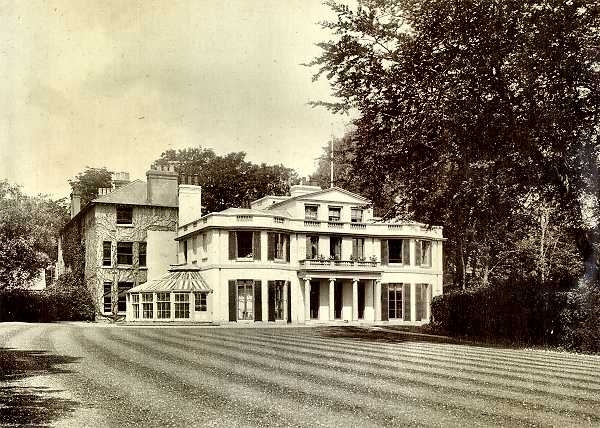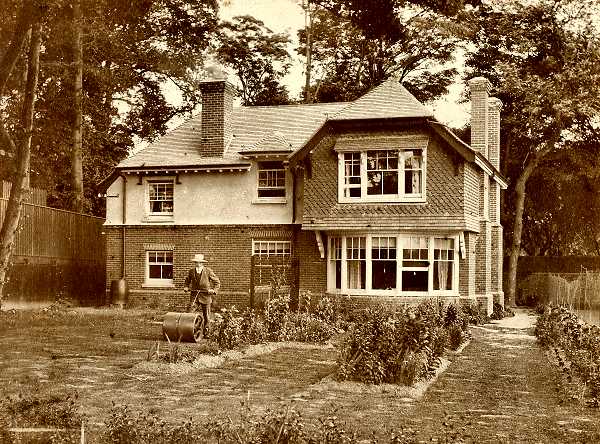the history of the former St Clare School in Upper Walmer.

|
 |
| St Clare School - main building | St Clare School - Masters' House |
| CLICK on these images to see larger versions | |
St Clare School of Grams Road, Upper Walmer, began life in 1857. Founded by a Mr A E Murray as a school for his seven children at the Manor House on West Hill in Hastings, it grew until in 1868 his eldest son, Alexander Elder Murray - aged just 24 - became headmaster. He continued in that role for 43 years.
Numbers increased to 28 boarders and two assistant masters were engaged. However, by 1890 numbers were declining and the decision was taken to move to Walmer in Kent. Their choice of new location was an impressive mansion, originally built by a Norwegian merchant named Andrew Gram in 1806. Classrooms and a chapel had been added in the late 1880s but had failed to succeed as a school. So, in August 1891, Alexander Murray and his school moved to these more commodious premises with 30 acres of grounds, and numbers soon began to increase.
Mr Murray resigned in 1911 and the running of the school was taken on by John Aston, an old boy, and G F White, a former assistant master. Then came the Great War. Mr Aston remained with the school for a year and then joined the army, serving with the East Surrey Regiment in Flanders where he was wounded, spending nine months in hospital. The Admiralty commandeered the premises and the school moved to join forces with Hillside School in Godalming, Surrey. Mr White carried on as headmaster, though numbers fell to 11 at one time. He then joined the RAF and Mr Aston returned in 1918.
The school returned to Walmer in 1919. Mr White retired in 1920 and a Mr Bernard, who had joined the staff in 1900, became joint head with Mr Aston. Numbers increased to 51 in 1925. Sadly though, ill health compelled Mr Aston to retire in 1926. James Hitchcock, initially in partnership with Mr Bernard, took over in 1926. An alumnus of St John’s, Leatherhead and St Catherine’s College, Cambridge, Mr Hitchcock had taught at several schools as well as serving with the Buffs in France during the Great War.
The school continued to prosper until, after the outbreak of World War II, it was decided in 1940 to evacuate from Walmer. Initially accommodation was found at Glastonbury in Somerset. Then, in 1941, came a move to a fresh location at the former Rectory at Duntisbourne Abbotts, near Cirencester, in Gloucestershire. Mr Bernard came out of retirement to help with teaching. The Rectory was shared with St Peter’s Court School of Burgess Hill in Sussex. Numbers fell alarmingly - possibly to as few as 15 - and, in summer 1943, St Clare closed for good.
Leelands, a girls’school, occupied a variety of premises in Walmer and evacuated to Benenden School during World War II. It took over the St Clare premises following the war. Leelands closed in 1986. The main school building was converted into private apartments known as Leelands House. The masters house became a private house. Both remain on Grams Road in Upper Walmer.
St Clare old boys include authors Dornford Yates and Graham Seton, Colonel John Duncan Grant VC, CB, DSO and Colonel Claude Lowther MP, founder of ‘Lowther’s Lambs’.
Michael Partridge, June 2014
Francis Watts contacted WalmerWeb in May 2015 to draw attention to another St Clare "old boy". John Gillespie Magee, the American pilot in the Royal Canadian Air Force who wrote the poem 'High Flight' ending with the memorable line "Put out my hand, and touched the face of God", was a pupil between 1931 and 1935.
The NMM also holds a letter from John's younger brother Graham (a distant cousin of Ian Harrison's wife) to his grandmother about the demise of his brother and seeking to give her some comfort. Ian has read the letter and says: "It is very poignant and drafted in the patriotic style of the time. It is amongst a number of letters of condolence to his uncle and his grandmother. John and Graham had a very 'broken' childhood with his parents splitting and his uncle taking custody of the boys and paying for their upbringing. Clearly, he paid St Clare's fees for John!"
Ian Harrison says he would welcome more information on John Pascoe. If anyone can help, Ian can be contacted by
| St Clare and Leelands Schools also feature on our other history pages and photo albums. | |||
| See: | |||
| On-line encyclopedia Wikipedia has more on some St Clare alumni: | |||
| Dornford Yates | Graham Seton | Colonel John Duncan Grant | |
| Colonel Claude Lowther | John Gillespie Magee | ||